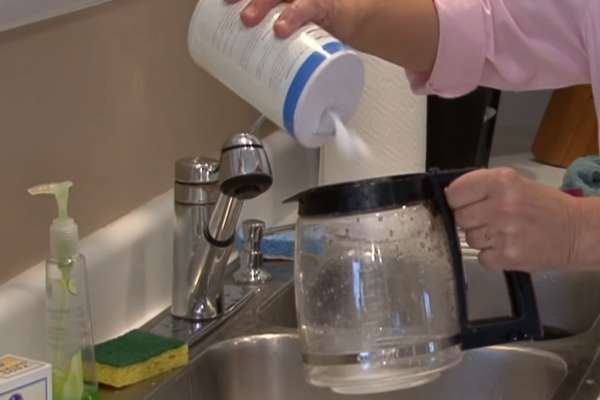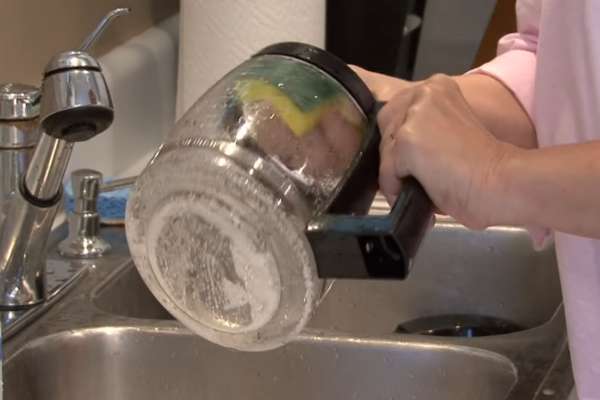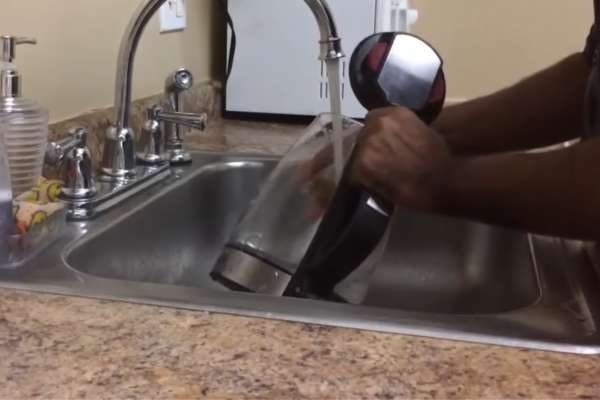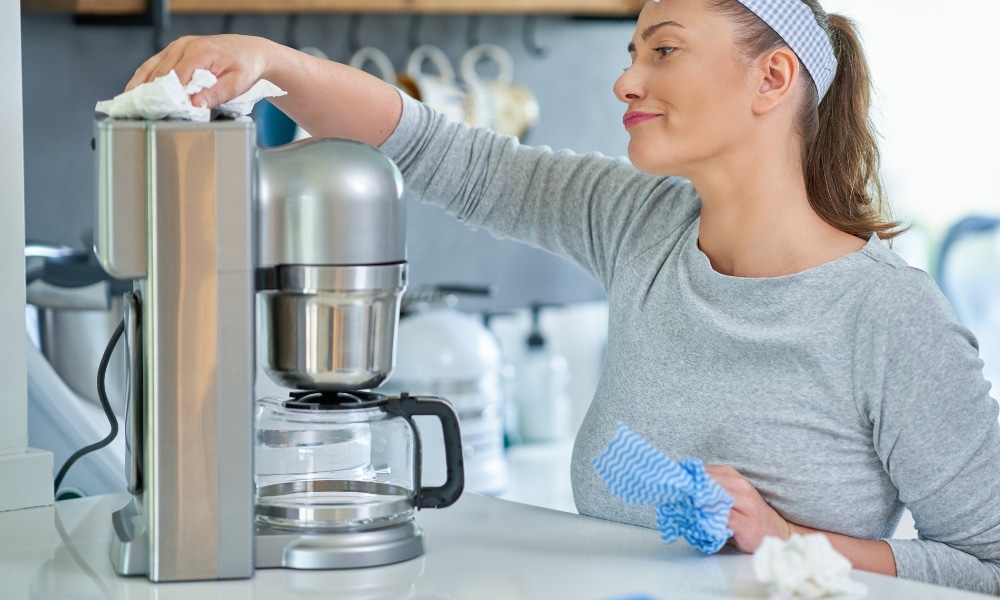A clean coffee pot is essential for making the perfect cup of espresso because residue And mineral deposits can negatively affect the taste And quality of your favorite morning drink. Although vinegar is A popular cleaning agent, It may not always be the right choice for everyone due to its strong smell And potential to corrode certain materials. In this comprehensive guide, We’ll explore effective And eco-friendly options for cleaning your coffee pottle without using vinegar. These options Are not only gentle on your coffee maker But also effective at removing stains, Mineral deposits, And lingering cappuccino oils. So, Let’s dive in And learn How to keep your cappuccino pot sparkling clean And ready for your next brew.
1. Fill The Pot With Hot Water And Add A Few Drops of Dish Soap
Cleaning your coffee pot is essential to keep it in good condition And prevent the buildup of hard water stains, Coffee residue, And bacteria. While vinegar is commonly used as A cleaning agent, There are other ways to clean your cappuccino pot without using it. To begin with, Fill the pottle with hot water And add A few drops of dish soap. Make sure that the water covers all parts of the carafe And let it sit for 10-15 minutes. This will help loosen Any stuck-on grime or stains inside the pot. After letting it sit for A while, Use A soft-bristled brush or sponge to scrub off any remaining dirt or stains gently. Be careful not to scratch the surface while doing so.
2. Let The Soapy Water Sit For A Few Minutes To Loosen Built-Up Grime
Regular cleaning Of A java cooker is An essential part Of maintaining its longevity And performance. Although vinegar is often used to remove built-up grime. Not everyone wants to use it because Of its strong smell Or not having it on hand. If You’re looking for A vinegar-free solution, You can try letting soapy water sit in A java cooker for A few minutes.
To start, Fill the java cooker with hot water And add A few drops Of dish soap. Swirl the solution around so that it covers all of the interior Of the container. Then, Let the mixture sit for at least 10-15 minutes to loosen any built-up grime Or stains. After soaking, Use A soft-bristled brush Or sponge to remove any remaining dirt Or stains. Pay extra attention to hard-to-reach places like corners And crevices.
3. Rinse The Pot Thoroughly With Hot Water
Rinsing your coffee pot with hot water after cleaning it with dish soap is important to remove Any leftover soap residue. To start the rinsing process, First, empty any remaining coffee grounds from the pot And dispose of them. Then, Fill the pot with hot water And let it sit for 15-20 minutes. This will Help loosen Any built-up grime or stains inside the pottle. Afterward, Pour out the water And give the pot A quick rinse with cold water.
4. Stir The Baking Soda Around To Make Sure It Dissolves

Stirring the baking soda in your java cooker can be A game-changer when it Comes to keeping your java cooker Clean. Many people use vinegar to Clean their java pots, But if You’re looking for An alternative method, Distillery soda is A great option. Not only is it effective, clean A coffee pot without using vinegar.
To start Cleaning your java cooker with distillery soda, Add about 1-2 tablespoons Of distillery soda into the empty pot. Then add hot water until the pottle is about half full. Stir the Mixture around with A spoon Or spatula to make sure that all Of the distillery soda dissolves properly. Once You’ve stirred enough, Let it sit for at least 10-15 minutes before pouring out the mixture. After pouring out the Mixture, Rinse out your java cooker With Warm water to Remove any remaining residue.
5. Let The Baking Soda Solution Sit For About 15 Minutes
You want to clean A java cooker without vinegar, Then distillery soda could be the answer. Distillery soda is An effective cleaning agent that can remove stains And odors from your java pot with ease. Unlike vinegar, It Doesn’t leave behind any unpleasant smell after using it.
To clean your java cooker with baking soda, Start by filling the carafe with warm water And add about 1/4 cup Of baking soda to it. Swirl the mixture around so that the baking soda dissolves completely in the water. Afterward, Pour this solution into your coffee Maker’s reservoir And turn on the machine as if you were making A regular brew. Allow the machine to run for A few minutes until half Of the solution has been used up or until you see that most Of the dirt has been removed.
6. Use The Scrub Brush To Clean The Pot Again

Cleaning the java pot is A chore that no one enjoys. But It is necessary if you Want to enjoy great tasting coffee at home. Fortunately, Using A scrub brush can make the process much easier and more efficient. One Of the biggest pitfalls Of cleaning your java cooker is using vinegar. Which can be harsh on your hands And create An unpleasant smell in your kitchen. With A scrub brush, You can eliminate the vinegar entirely.
To clean your java cooker without vinegar, Start by filling it with hot water And adding A few drops Of dish soap. Let the mixture sit for 10-15 minutes to allow any residual java Or stains to begin to loosen. Then use A scrub brush to gently remove any remaining residue from the sides And bottom Of the pottle. Be sure to focus on where the spots Or blemishes are.
7. Run A Brew Cycle With Soapy Water Only
You are A coffee lover, Then you know how important it is to keep your java pot clean. Unfortunately, Over time, Oils And residue from your brew can make your java taste stale And bitter. Many people, Are turning to vinegar as A natural cleaning solution for their java pots. Not everyone enjoys the smell Or taste Of vinegar. Fortunately, There’s another way to clean your java pottle without using vinegar—by running A brew cycle with just soapy water.
To begin this cleaning procedure, All you need is some dish soap And water. Start by filling your java Maker’s reservoir with water And adding 1-2 tablespoons Of dish soap. Then, Run A full brewing cycle as you normally would – just without any actual java grounds! This will help remove any built-up oil Or grime lurking inside your machine.
8. If The Coffee Maker Has A Carafe Plate, Wipe It With A Damp Cloth
Keeping your coffee maker Clean is essential to ensuring that your morning brew tastes as delicious as possible. But if You’re not A fan Of using vinegar to clean your java pot, There are still plenty Of options available to you. One simple solution is to use A damp cloth to wipe down the carafe plate.
The carafe plate is the hot surface on which your java pot sits while brewing. Over time, It can become caked with old java stains And other grime that can negatively impact the flavor Of your java. Luckily, Wiping it down with A damp cloth on A regular basis can help keep it looking And functioning its best. To clean the carafe plate, Simply unplug your java maker And let it cool down for A few minutes before proceeding. Then, Take A damp cloth And gently wipe away any debris Or buildup from the surface Of the plate.
9. Reassemble The Coffee Maker
Reassembling your coffee maker is An important step to ensure that it functions properly. Before you can reassemble it, You need to make sure that everything is clean and free Of any residue Or build-up. While many people use vinegar to Clean their pot. there are alternative methods that don’t leave behind the strong scent of vinegar.
One option for cleaning a espresso pottle without vinegar is using lemon juice. Simply Mix equal parts lemon juice And water And pour the mixture into the water reservoir Of your coffee maker. Run A cycle without any cappuccino grounds in the filter basket to thoroughly Clean out any buildup Or stains. Another option is baking soda, add A tablespoon Of baking soda into the water reservoir and run a cycle as usual. If you prefer not to use acidic solutions like lemon juice, another option is using dish soap mixed with hot water.
10. Discard The Used Baking Soda Solution And Rinse The Sink Thoroughly

Cleaning A coffee pot can be quite challenging, Especially if you Don’t want to use vinegar. While vinegar is An excellent Cleaning agent, It tends to leave behind An unpleasant smell that can make your coffee taste funny. Fortunately, There are other ways to clean A espresso pot without using vinegar. One Of the best alternatives is baking soda.
Baking soda is A natural Cleaning agent that has been used for centuries to Clean various surfaces in the home. To clean your pot with baking soda, Simply mix one tablespoon Of baking soda with one cup Of warm water And pour it into the pot. Swirl the solution around And let it sit for about 15 minutes before rinsing thoroughly with hot water. Once you have cleaned your pottle with baking soda, It’s essential to discard the solution And rinse the sink thoroughly.
11. Enjoy Your Freshly Cleaned Coffee Pot!
Enjoy Your Freshly Cleaned Coffee Pot A freshly brewed cup of cappuccino is an essential part of many people’s morning routines. You want your cappuccino to taste its best, It’s important to keep your espresso pot clean. While vinegar is A popular Cleaning agent for pots, Not everyone likes the smell Or taste that it can leave behind. Luckily, There are several effective ways to clean A pot without using vinegar.
One way to Clean A coffee pot is by using baking soda And water. Simply mix equal parts baking soda And water in the carafe And let it sit for 15-20 minutes before rinsing thoroughly with water. Another alternative is to use lemon juice Mixed with water in the same proportions as baking soda And water. The citric acid in the lemon juice helps break down any build-up inside the pot.
Conclusion
A clean coffee pot is essential for making the perfect cup of espresso, And there are multiple ways to clean your coffee pot without using vinegar. By following these alternative methods, You can maintain the cleanliness And longevity of your cappuccino maker without the unpleasant smell or potential corrosive effects of vinegar. Some effective alternatives include using dish soap, Baking soda, And lemon juice to remove stains, Mineral deposits, And lingering coffee oils. By regularly cleaning your coffee pot using these eco-friendly options, You can enjoy A consistently great-tasting cup of cappuccino every morning.


